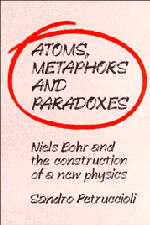Book contents
- Frontmatter
- Contents
- Introduction
- 1 The paradigm of complementarity
- 2 Atomic model and quantum hypotheses
- 3 The principle of correspondence
- 4 The theory of virtual oscillators
- 5 The conceptual foundation of quantum mechanics
- 6 The Bohr—Einstein confrontation: phenomena and physical reality
- General bibliography
- Name index
- General index
4 - The theory of virtual oscillators
Published online by Cambridge University Press: 10 November 2009
- Frontmatter
- Contents
- Introduction
- 1 The paradigm of complementarity
- 2 Atomic model and quantum hypotheses
- 3 The principle of correspondence
- 4 The theory of virtual oscillators
- 5 The conceptual foundation of quantum mechanics
- 6 The Bohr—Einstein confrontation: phenomena and physical reality
- General bibliography
- Name index
- General index
Summary
‘At the present state of science it does not seem possible to avoid the formal character of the quantum theory which is shown by the fact that the interpretation of atomic phenomena does not involve a description of the mechanism of the discontinuous processes […]. On the correspondence principle it seems nevertheless possible to […] arrive at a consistent description of optical phenomena by connecting the discontinuous effects occurring in atoms with the continuous radiation field […]’. This announced a turning point in atomic physics research; for the first time there were reasons to assert that discontinuity was not in itself incompatible with the theory's descriptive content, and rational solutions were provided that related a whole set of phenomena dependent on the radiation properties of matter to the continuous picture of the radiation field. This was the conclusion arrived at in a new paper by Bohr which took up and developed the hypothesis put forward by the American physicist John Slater that ‘the atom, even before a process of transition between two stationary states takes place, is capable of communication with distant atoms through a virtual radiation field’ was taken up and developed. The article, ‘The Quantum Theory of Radiation’, signed by Bohr, Kramers and Slater, was published in the Philosophical Magazine in January 1924.
Slater had arrived in Copenhagen at the end of the preceding year with the idea that his hypothesis might lead to very different theoretical results.
- Type
- Chapter
- Information
- Atoms, Metaphors and ParadoxesNiels Bohr and the Construction of a New Physics, pp. 111 - 133Publisher: Cambridge University PressPrint publication year: 1993



